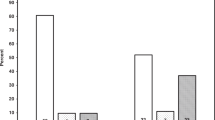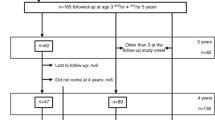Abstract
Background
Preterm very-low-birth-weight (PT-VLBW) infants are at risk of an elevated systolic blood pressure (SBP) in infancy and adulthood; however, the pathogenesis remains unclear. Altered renal development or function may be associated with increased SBP, but their contribution in PT-VLBW is unknown.
Methods
We determined renal function and its relationship to SBP in three groups of PT-VLBW at 1, 2, and 3 years of age, using serum cystatin-C to calculate the estimated glomerular filtration rate (eGFR).
Results
Cystatin-C levels decreased from 0.84 ± 0.2 (SD) within the 1-year group to 0.70 ± 0.1 mg/l (±SD; P < 0.001) at 3 years and were unrelated to gender, fetal growth, and neonatal indomethacin exposure. eGFR rose from 121 ± 59 in the 1-year group to 138 ± 21 ml/min·1.73 m2 (P < 0.001) at 3 years. At 1 year, cystatin-C levels decreased with increasing SBP (P < 0.007), and infants with SBP ≥ 90th% had lower cystatin-C and higher eGFR (P < 0.05). At 3 years, infants with lower birth weight (P < 0.03) and gestational age (P = 0.06) had reduced eGFR.
Conclusions
Preterm very-low-birth-weight infants demonstrate increasing renal function with advancing age. An elevated SBP and eGFR at 1 year suggests dysfunctional renal autoregulation and hyperfiltration, which may alter subsequent renal function and contribute to the lower eGFR seen at 3 years in infants with the lowest birth weight and gestational age.


Similar content being viewed by others
References
Barker DJ, Osmond C, Golding J, Kuh D, Wadsworth ME (1989) Growth in utero, blood pressure in childhood and adult life, and mortality from cardiovascular disease. BMJ 298:564–567
Barker DJ, Bagby SP, Hanson MA (2006) Mechanisms of disease: in utero programming in the pathogenesis of hypertension. Nat Clin Pract Nephrol 2:700–707
Barker DJ, Osmond C, Kajantie E, Eriksson JG (2009) Growth and chronic disease: findings in the Helsinki Birth Cohort. Ann Hum Biol 36:445–458
Barker DJ (2004) Developmental origins of adult health and disease. J Epidemiol Community Health 58:114–115
McMillen IC, Robinson JS (2005) Developmental origins of the metabolic syndrome: prediction, plasticity, and programming. Physiol Rev 85:571–633
Huxley RR, Shiell AW, Law CM (2000) The role of size at birth and postnatal catch-up growth in determining systolic blood pressure: a systematic review of the literature. J Hypertens 18:815–831
Siewert-Delle A, Ljungman S (1998) The impact of birth weight and gestational age on blood pressure in adult life: a population-based study of 49-year-old men. Am J Hypertens 11:946–953
Johansson S, Iliadou A, Bergvall N, Tuvemo T, Norman M, Cnattingius S (2005) Risk of high blood pressure among young men increases with the degree of immaturity at birth. Circulation 112:3430–3436
Pharoah PO, Stevenson CJ, West CR (1998) Association of blood pressure in adolescence with birthweight. Arch Dis Child Fetal Neonatal Ed 79:F114–F118
Hack M, Schluchter M, Cartar L, Rahman M (2005) Blood pressure among very low birth weight (< 1.5 kg) young adults. Pediatr Res 58:677–684
Hovi P, Andersson S, Raikkonen K, Strang-Karlsson S, Jarvenpaa AL, Eriksson JG, Pesonen AK, Heinonen K, Pyhala R, Kajantie E (2010) Ambulatory blood pressure in young adults with very low birth weight. J Pediatr 156(54–59):e51
Vohr BR, Allan W, Katz KH, Schneider KC, Ment LR (2010) Early predictors of hypertension in prematurely born adolescents. Acta Paediatr 99:1812–1818
Duncan AF, Rosenfeld CR, Morgan JS, Ahmad N, Heyne RJ (2008) Interrater reliability and effect of state on blood pressure measurements in infants 1 to 3 years of age. Pediatrics 122:e590–e594
Duncan AF, Heyne RJ, Morgan JS, Ahmad N, Rosenfeld CR (2011) Elevated systolic blood pressure in preterm very-low-birth-weight infants ≤ 3 years of life. Pediatr Nephrol 26:1115–1121
Zandi-Nejad K, Luyckx VA, Brenner BM (2006) Adult hypertension and kidney disease: the role of fetal programming. Hypertension 47:502–508
Brenner BM, Garcia DL, Anderson S (1988) Glomeruli and blood pressure. Less of one, more the other? Am J Hypertens 1:335–347
Bagby SP (2007) Maternal nutrition, low nephron number, and hypertension in later life: pathways of nutritional programming. J Nutr 137:1066–1072
Dotsch J, Plank C, Amann K, Ingelfinger J (2009) The implications of fetal programming of glomerular number and renal function. J Mol Med 87:841–848
Baum M (2010) Role of the kidney in the prenatal and early postnatal programming of hypertension. Am J Physiol Renal Physiol 298:F235–F247
Brenner BM, Chertow GM (1994) Congenital oligonephropathy and the etiology of adult hypertension and progressive renal injury. Am J Kidney Dis 23:171–175
Bagby SP (2009) Developmental origins of renal disease: should nephron protection begin at birth? Clin J Am Soc Nephrol 4:10–13
Luyckx VA, Brenner BM (2010) The clinical importance of nephron mass. J Am Soc Nephrol 21:898–910
Keijzer-Veen MG, Schrevel M, Finken MJ, Dekker FW, Nauta J, Hille ET, Frolich M, van der Heijden BJ (2005) Microalbuminuria and lower glomerular filtration rate at young adult age in subjects born very premature and after intrauterine growth retardation. J Am Soc Nephrol 16:2762–2768
Bacchetta J, Harambat J, Dubourg L, Guy B, Liutkus A, Canterino I, Kassai B, Putet G, Cochat P (2009) Both extrauterine and intrauterine growth restriction impair renal function in children born very preterm. Kidney Int 76:445–452
Rodriguez MM, Gomez AH, Abitbol CL, Chandar JJ, Duara S, Zilleruelo GE (2004) Histomorphometric analysis of postnatal glomerulogenesis in extremely preterm infants. Pediatr Dev Pathol 7:17–25
Gubhaju L, Sutherland MR, Black MJ (2011) Preterm birth and the kidney: implications for long-term renal health. Reprod Sci 18:322–333
Hughson M, Farris AB III, Douglas-Denton R, Hoy WE, Bertram JF (2003) Glomerular number and size in autopsy kidneys: The relationship to birth weight. Kidney Int 63:2113–2122
Manalich R, Reyes L, Herrera M, Melendi C, Fundora I (2000) Relationship between weight at birth and the number and size of renal glomeruli in humans: a histomorphometric study. Kidney Int 58:770–773
Hinchliffe SA, Sargent PH, Howard CV, Chan YF, van Velzen D (1991) Human intrauterine renal growth expressed in absolute number of glomeruli assessed by the disector method and Cavalieri principle. Lab Invest 64:777–784
Rodriguez-Soriano J, Aguirre M, Oliveros R, Vallo A (2005) Long-term renal follow-up of extremely low birth weight infants. Pediatr Nephrol 20:579–584
2004 National High Blood Pressure Education Program Working Group on High Blood Pressure in Children and Adolescents (2004) The fourth report on the diagnosis, evaluation, and treatment of high blood pressure in children and adolescents. Pediatrics 114:555–576
Finney H, Newman DJ, Gruber W, Merle P, Price CP (1997) Initial evaluation of cystatin C measurement by particle-enhanced immunonephelometry on the Behring nephelometer systems (BNA, BN II). Clin Chem 43:1016–1022
Filler G, Lepage N (2003) Should the Schwartz formula for estimation of GFR be replaced by cystatin C formula? Pediatr Nephrol 18:981–985
Tabachnick B, Fidell L (1996) Using multivariate statistics, 5th edn. Harper Collins College, New York, pp 127–195
Grubb AO (2000) Cystatin C—properties and use as diagnostic marker. Adv Clin Chem 35:63–99
Tenstad O, Roald AB, Grubb A, Aukland K (1996) Renal handling of radiolabelled human cystatin C in the rat. Scand J Clin Lab Invest 56:409–414
Newman DJ (2002) Cystatin C. Ann Clin Biochem 39:89–104
Roos JF, Doust J, Tett SE, Kirkpatrick CM (2007) Diagnostic accuracy of cystatin C compared to serum creatinine for the estimation of renal dysfunction in adults and children—a meta-analysis. Clin Biochem 40:383–391
Jerums G, Premaratne E, Panagiotopoulos S, Clarke S, Power DA, MacIsaac RJ (2008) New and old markers of progression of diabetic nephropathy. Diabetes Res Clin Pract 82 [Suppl 1]:S30–S37
Andersen TB, Eskild-Jensen A, Frokiaer J, Brochner-Mortensen J (2009) Measuring glomerular filtration rate in children; can cystatin C replace established methods? A review. Pediatr Nephrol 24:929–941
Finney H, Newman DJ, Thakkar H, Fell JM, Price CP (2000) Reference ranges for plasma cystatin C and creatinine measurements in premature infants, neonates, and older children. Arch Dis Child 82:71–75
Guignard JP, John EG (1986) Renal function in the tiny, premature infant. Clin Perinatol 13:377–401
Heilbron DC, Holliday MA, al-Dahwi A, Kogan BA (1991) Expressing glomerular filtration rate in children. Pediatr Nephrol 5:5–11
Rhodin MM, Anderson BJ, Peters AM, Coulthard MG, Wilkins B, Cole M, Chatelut E, Grubb A, Veal GJ, Keir MJ, Holford NH (2009) Human renal function maturation: a quantitative description using weight and postmenstrual age. Pediatr Nephrol 24:67–76
Vanpee M, Blennow M, Linne T, Herin P, Aperia A (1992) Renal function in very low birth weight infants: normal maturity reached during early childhood. J Pediatr 121:784–788
Hodgin JB, Rasoulpour M, Markowitz GS, D'Agati VD (2009) Very low birth weight is a risk factor for secondary focal segmental glomerulosclerosis. Clin J Am Soc Nephrol 4:71–76
Moritz KM, Wintour EM, Black MJ, Bertram JF, Caruana G (2008) Factors influencing mammalian kidney development: implications for health in adult life. Adv Anat Embryol Cell Biol 196:1–78
Simeoni U, Ligi I, Buffat C, Boubred F (2011) Adverse consequences of accelerated neonatal growth: cardiovascular and renal issues. Pediatr Nephrol 26:493–508
Acknowledgements
This study was supported by a Marshall Klaus Research Award from the American Academy of Pediatrics, Section on Perinatal Pediatrics awarded to Dr Duncan and the George M MacGregor Professorship in Pediatrics awarded to Dr Rosenfeld.
Author information
Authors and Affiliations
Corresponding author
Rights and permissions
About this article
Cite this article
Frankfurt, J.A., Duncan, A.F., Heyne, R.J. et al. Renal function and systolic blood pressure in very-low-birth-weight infants 1–3 years of age. Pediatr Nephrol 27, 2285–2291 (2012). https://doi.org/10.1007/s00467-012-2265-y
Received:
Revised:
Accepted:
Published:
Issue Date:
DOI: https://doi.org/10.1007/s00467-012-2265-y




